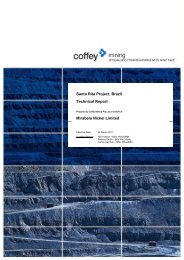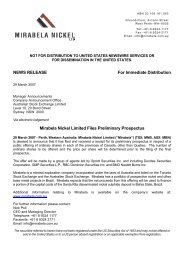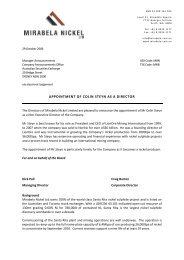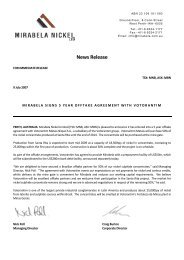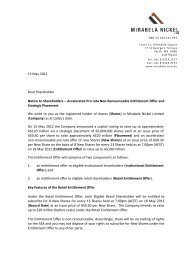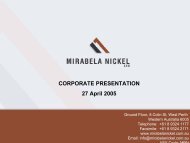COPY OF FINAL PROSPECTUS - Mirabela Nickel
COPY OF FINAL PROSPECTUS - Mirabela Nickel
COPY OF FINAL PROSPECTUS - Mirabela Nickel
Create successful ePaper yourself
Turn your PDF publications into a flip-book with our unique Google optimized e-Paper software.
multinational mining companies active in Brazil include Anglo American PLC, Rio Tinto PLC and BHP<br />
Billiton Ltd. CVRD, a Brazilian company, has become the second largest nickel producer in the world following<br />
its acquisition of Inco.<br />
Under the Brazilian Constitution, mineral deposits represent a class of property separate from surface<br />
rights, and belong to the Republic of Brazil. Exploration and mining activities can only be undertaken by<br />
Brazilian individuals or legal entities incorporated in Brazil which hold an authorization or concession granted<br />
by the federal government of Brazil.<br />
The Mining Code of 1967 (the ‘‘Mining Act’’) and the Brazilian Mining Code Regulation 1968<br />
(the ‘‘Regulation’’ and together, the ‘‘Mining Code’’) govern the exploration and commercial exploitation of<br />
mineral resources in Brazil. Under the Mining Code, mining activity requires the grant of a concession from the<br />
DNPM, an agency of the Brazilian federal government responsible for controlling and applying the Mining<br />
Code, and requires an agreement with the relevant landowner regarding surface rights. Accordingly, mining<br />
tenements in Brazil generally consist of one or more prospecting permits, exploration licences and mining<br />
concessions.<br />
The Mining Code does not require that the holder of a granted exploration licence or mining concession<br />
spend a prescribed amount on exploration or mining activities.<br />
The Company holds, directly or indirectly, exploration licences and applications for exploration licences and<br />
is preparing to submit one or more applications for mining concessions.<br />
Exploration Licences<br />
An exploration licence entitles a holder, to the exclusion of all others, to explore for minerals in the area of<br />
the licence but not to conduct commercial mining. The maximum exploration area for nickel is 2,000 hectares in<br />
the States of Bahia and Piaui and 10,000 hectares in the State of Tocantins. An exploration licence is valid for a<br />
maximum period of three years and can be extended by no longer than one additional three year period. The<br />
holder of an exploration licence must (i) inform the DNPM of the discovery of any other mineral substance not<br />
included in the exploration licence; (ii) perform work in accordance with applicable environmental legislation;<br />
(iii) report annually to the DNPM on exploration expenditures; (iv) compensate the surface owner for<br />
occupation of land and for losses caused by the work; and (v) submit a final report of the results of the work to<br />
the DNPM before termination of the exploration licence. In addition, the holder of an exploration licence must<br />
pay an annual exploration fee to the DNPM. The fee is established at progressive values based on the size of<br />
the area and the extension period of the licence.<br />
If the final report demonstrates the existence of a resource which can be both technically and financially<br />
developed, the DNPM will generally approve the report. Once the exploration report is approved, the holder of<br />
an exploration licence has one year to apply for a mining concession. If the holder of an exploration licence fails<br />
to apply for a mining concession within this one year period, the mineral rights over the property will lapse.<br />
Mining Concessions<br />
An application for a mining concession must be addressed to the DNPM and be supported by a<br />
development plan and a mining plan. A mining concession will not be issued until an installation licence has<br />
been granted by the applicable environmental authority. See ‘‘Environmental Licensing’’ below.<br />
A mining concession is granted under ordinance of the Ministry of Mines and Energy. The area of the<br />
mining concession will be limited to (and can be smaller than) the area of the exploration licence from which it is<br />
derived. Subject to complying with its conditions, a mining concession entitles the holder thereof, to the<br />
exclusion of others, to mine the mining lease area indefinitely, until full depletion of the deposit. The holder of a<br />
mining concession is entitled to servitudes over the land covered by the concession for mining, processing and<br />
infrastructure or over adjacent land for processing and infrastructure. In very occasional circumstances mining<br />
rights can be denied where the government mining authority considers that a subsequent public interest exceeds<br />
that of the utility of mineral exploration, in which case the Federal Government must compensate the mining<br />
concession holder.<br />
22




